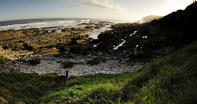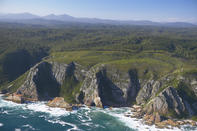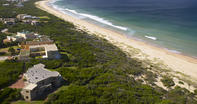Stone Age Implements
The Garden Route is made up of many small and less small towns dotted along the Cape coast and slightly inland of South Africa. Each town has a rich and distant history. They all start with early man utilising the abundance of game and fish found in the area.

Stone Age implements have been found on more than one site, as have shell middens in caves. Hunter-gatherer artefacts have also been found showing that the Khoi-Khoi tribes foraged in this area, especially along the seashores of the Indian Ocean. 2000 odd years ago, nomadic herders utilised the verdant mountains and streams and meandered up and down the coast.
Fairly recently, give or take a hundred years, European seafarers found their way to the South African shores, on their voyages to find passages between Europe and India.
As they obviously had left their Global Positioning System GPS at home, they stumbled, accidentally onto the Cape shores. Finding safe harbours, natural forests and an abundance of game they settled.
When the Dutch East India Company established itself in the Cape in 1652, it didn’t take long for explorers to spread out in search of lucrative things to trade with.
Using ox wagons and horses, these intrepid folk forged their way along the coast. Some of them liked what they found along the way and stayed. Establishing homesteads, trading posts and farms.
The Natural Forest Belt

The natural forest belt along the coastal region was perfect for timber. It didn’t take long for sawmills and shipyards to spring up and trade to start. Then gold was found in 1876. The rush was on, speculators from all around converged in their quest for riches.
From the gold a town grew, but the seam was poor, the lure of greater riches on the Witwatersrand was greater and off the prospectors went. Some miners stayed behind and formed hamlets, which later grew in size to form many of the towns we have today.
These settlers brought tools, knowledge and industry to the area and built fine towns. They also plundered the forests for timber and hunted unreservedly.
Within 200 years much of the forest was decimated and the wild game has gone. Nowadays, South African National Parks protect the forests and eco-sensitive areas, so that they can be preserved and enjoyed by all.
Very Recent History

In more recent history, highways joining the small towns between Port Elizabeth and Cape Town have enabled tourists to easily explore the area. Many guesthouses, hotels, restaurants and bars have become established enabling the weary traveller a well-earned respite from the rigours of adrenaline pumping activities and relaxing activities that are found here today.
Very recent history, in 2017 huge fires spread throughout Knysna engulfing many homesteads and causing misery and loss to people, animals and the indigenous forests. But, just like the mythical phoenix Knysna and her forest have risen from the ashes. Rebuilding has commenced with many tourist establishments reopening in 2018.
The festivals continue as once before and Knysna is still a wonderful place to visit. The forest, with its many fire resistant and fire germinating plants has new growth and will revert back to its full glory very quickly. Isn’t nature a wonderful thing?
 The Garden Route is a great way to explore the Cape Coastal region of South Africa. You can either embark on a self drive route, lingering l...
The Garden Route is a great way to explore the Cape Coastal region of South Africa. You can either embark on a self drive route, lingering l... There are South African Tourism Routes to suit you. Read this quick concise guide by independent travel writer Carrie Hampton and choose a r...
There are South African Tourism Routes to suit you. Read this quick concise guide by independent travel writer Carrie Hampton and choose a r...